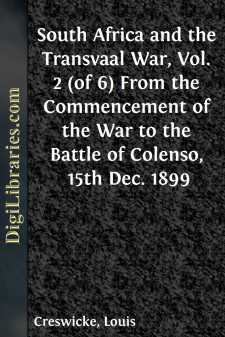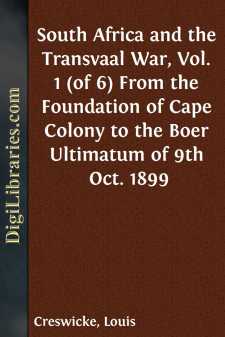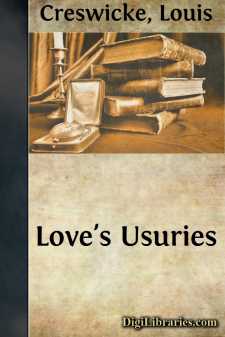Categories
- Antiques & Collectibles 13
- Architecture 36
- Art 48
- Bibles 22
- Biography & Autobiography 813
- Body, Mind & Spirit 142
- Business & Economics 28
- Children's Books 17
- Children's Fiction 14
- Computers 4
- Cooking 94
- Crafts & Hobbies 4
- Drama 346
- Education 46
- Family & Relationships 57
- Fiction 11829
- Games 19
- Gardening 17
- Health & Fitness 34
- History 1377
- House & Home 1
- Humor 147
- Juvenile Fiction 1873
- Juvenile Nonfiction 202
- Language Arts & Disciplines 88
- Law 16
- Literary Collections 686
- Literary Criticism 179
- Mathematics 13
- Medical 41
- Music 40
- Nature 179
- Non-Classifiable 1768
- Performing Arts 7
- Periodicals 1453
- Philosophy 64
- Photography 2
- Poetry 896
- Political Science 203
- Psychology 42
- Reference 154
- Religion 513
- Science 126
- Self-Help 84
- Social Science 81
- Sports & Recreation 34
- Study Aids 3
- Technology & Engineering 59
- Transportation 23
- Travel 463
- True Crime 29
South Africa and the Transvaal War, Vol. 2 (of 6) From the Commencement of the War to the Battle of Colenso, 15th Dec. 1899
by: Louis Creswicke
Description:
Excerpt
CHRONOLOGICAL TABLE—Vol. II.
OCTOBER.
11.—Boer Ultimatum time-limit expired. Great Britain commenced to be at war with Transvaal and Orange Free State.
12.—Text of Great Britain's reply to Boer Ultimatum issued. It stated that the conditions demanded were such as her Majesty's Government deemed it impossible to discuss.
Mr. Conyngham Greene recalled.
Armoured train captured by Boers near Mafeking.
Colonel Baden-Powell moved a large force outside Mafeking, and took up a strong defensive position.
13.—Newcastle abandoned.
14.—Sir R. Buller and Staff left England.
15.—Boers occupied Newcastle.
16.—Dundee evacuated.
17.—Parliament opened.
Successful sortie by Colonel Baden-Powell from Mafeking.
Armoured train in action near Kimberley during reconnaissance.
18.—Mr. Balfour announced that the Militia and Militia Reserves were to be called out.
19.—Transvaal flag hoisted at Vryburg.
20.—Boers repulsed by British at Talana Hill (Glencoe).
21.—General French, with about 2000 men, attacked a Boer force under General Kock at Elandslaagte.
22.—General Symons promoted to be Major-General.
General Yule retired from Dundee on Ladysmith.
23.—Death of General Symons.
Mafeking bombarded.
Transvaal National Bank seized at Durban.
24.—Sir George White engaged Boers at Reitfontein.
Services accepted of Sir William M'Cormac, President of the Royal College of Surgeons, to attend the wounded.
26.—Generals Yule and White joined forces at Ladysmith.
Bombardment of Mafeking commenced.
28.—Boers were closing round Ladysmith.
Proclamation issued declaring the Boer "commandeering" of certain portions of Cape Colony null.
30.—Engagement at Lombard's Kop.
Sir George White sent out from Ladysmith to Nicholson's Nek a Mountain Battery, with the Irish Fusiliers and the Gloucesters, to turn the enemy's right flank. Mules, with guns and reserve ammunition, stampeded into enemy's lines. After gallantly defending their position for six hours, men's ammunition was exhausted, and about 800 were captured. Naval Brigade did excellent work.
31.—Sir Redvers Buller landed at Cape Town.
NOVEMBER.
1.—Boers invaded Cape Colony.
2.—Free Staters' position at Besters brilliantly taken by cavalry. Boers lost heavily; our casualties slight. Boers treacherously used white flag.
Colenso evacuated by the British.
Arrangements for a supplementary Naval Brigade completed.
Orders issued for mobilising the Militia.
3.—Naauwpoort and Stormberg evacuated by the British garrisons.
5.—Death of Commander Egerton, of Powerful.
6.—Ladysmith isolated.
9.—Boers attacked Ladysmith, and repulsed with heavy loss.
Orders issued for mobilisation of a Fifth Division.
10.—Engagement of Belmont. Colonel Keith Falconer killed.
11.—Captain Percy Scott, of H.M.S. Terrible, appointed commandant of the forces defending Durban.
12.—Lord Methuen arrived at Orange River.
14.—Lieutenant-General Sir Charles Warren appointed to command the Fifth Division for service in South Africa.
15.—Armoured train wrecked by Boers near Frere. Mr. Winston Churchill and a number of Dublin Fusiliers and Volunteers captured.
Boers defeated at Estcourt.
16.—Fighting near Orange River.
17-22.—Transports arrived at Cape Town with 22,000 troops.
20.—Lord Methuen's force reached Witteputts.
23.—Lord Methuen attacked Boers at Belmont.
Boers routed at Willow Grange.
25.—Lord Methuen engaged the Boers at Graspan (Enslin), and after four hours' hard fighting carried position.
26.—Mooi River Column joined at Frere by General Hildyard.
28.—Lord Methuen engaged enemy, 8000 strong, at Modder River, and after ten hours' desperate fighting, drove them back.
30.—Sixth Division for South Africa notified.
DECEMBER.
2.—General Clery reached Frere.
3.—Transport Ismore wrecked 180 miles north of Cape Town—all troops landed.
6.—Sortie from Kimberley. Major Scott Turner killed.
7.—Arundel occupied by British.
8.—British sortie from Ladysmith, Lombard's Kop being carried.
9.—General Gatacre sustained serious reverse at Stormberg, having been misled by guides.
Lieutenant-Colonel Metcalfe, 2nd Rifle Brigade, with 500 men from Ladysmith, captured Surprise Hill, destroying a howitzer.
10.—General French drove the enemy from Vaal Kop.
11.—Lord Methuen attacked 12,000 Boers entrenched at Majesfontein, but attack failed, although British troops held their position. Major-General Wauchope, Major Lord Winchester, and Colonel Downman killed.
13.—General French defeated 1800 Boers between Arundel and Naauwpoort. British loss, 1 killed, 8 wounded.
14.—Orders given for the mobilisation of a Sixth Division, and a Seventh in reserve.
Sir Charles Warren and Staff arrived at the Cape.
15.—General Buller suffered a serious reverse at Colenso, troops having to retire to Chieveley, leaving behind 11 guns.
General Hector Macdonald appointed to succeed General Wauchope.
as issued by the War Office, 7th October, 1899.
LINES OF COMMUNICATION.
The Lines of Communication will be under the general command and direction of Lieut.-General Sir F. W. E. F. Forestier-Walker, K.C.B., C.M.G.
The following Officers will be employed and will have the Staff position shown opposite their names:—
Colonel H. H. Settle, C.B., D.S.O., p.s.c.Colonel on Staff.Captain F. A. Molony, p.s.c., R.E....



